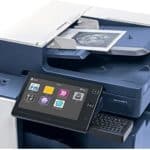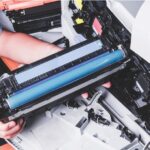How to Make Copies: A Step-by-Step Guide (For Beginners)
How to Make Copies?
Making copies is a fundamental skill that comes in handy throughout life, from academic pursuits to professional tasks and personal projects. Whether you’re a student needing duplicates of class notes, an employee replicating important documents, or simply someone wanting to save documents, understanding how to copy efficiently is an essential tool.
This comprehensive guide explains into the various methods available for creating copies, empowering you to navigate the world of replication with confidence. We’ll explore the functionalities of photocopiers, the benefits of scanners, and even delve into some clever digital copying methods.
What are Different Copying Methods
There are multiple methods to make copies. Let’s explore the diverse options to make copier:
Utilizing the Power of Photocopiers
A photocopier, sometimes referred to as a photoduplicator, is a remarkable machine that generates physical replicas of documents. In essence, it utilizes light to capture an image of the original document, then transfers that image onto a new sheet of paper using a toner or ink process. Photocopiers come in various forms:
- Analog photocopiers: These are the traditional machines, employing light-sensitive materials to create copies.
- Digital photocopiers: Employing digital technology, these photocopiers offer enhanced features like image editing and scaling.
- Multi-function printers (MFPs): These versatile devices combine the functionalities of a photocopier, printer, and scanner in one convenient unit.

The copying process on a photocopier is generally straightforward. You simply place the original document face down on the designated glass platen, adjust settings like copy size and quantity, and press the start button. The photocopier then scans the document, processes the image, and delivers a crisp copy within seconds.
Advantages of Scanners
Scanners are digital options that transform physical documents into electronic files. Unlike photocopiers that produce physical copies, scanners create digital representations that can be stored, edited, and shared electronically. This offers several advantages:
- Digital format: Scanned documents are readily accessible on your computer or cloud storage, eliminating the need for physical copies and saving valuable space.
- Editing capabilities: Scanned documents can be edited using image editing software, allowing for annotations, redactions, or even format conversions to searchable PDFs.

Scanners come in two primary configurations:
- Flatbed scanners: These scanners require you to place the document face down on a glass platen, similar to a photocopier. A scanning head then moves across the document to capture the image.
- Document feeder scanners: These scanners boast an automatic document feeder that allows you to scan multiple pages consecutively, ideal for high-volume tasks.
For instance, if you need to archive a collection of old family photos, a scanner would be the ideal choice. You could scan the photos, save them digitally on your computer, and even enhance their quality using editing software.
Exploring Digital Copying Methods
The digital age has assist in innovative ways to create copies without relying on traditional hardware. Here are a couple of ingenious methods to consider:
- Taking screenshots: Most operating systems offer built-in functionality to capture an image of your computer screen, essentially creating a digital copy of what’s displayed. This is a convenient way to grab specific portions of a web page or document for reference.
- Utilizing online tools: Several web-based tools allow you to capture specific regions of a web page or document. These tools offer an advantage in terms of accessibility and ease of use, often requiring just a few clicks to generate a copy.
However, digital copying methods do have limitations. Screenshots, for example, might only capture a portion of the screen, and online tools may have restrictions on file size or privacy considerations.
Making Copies Using a Photocopier
Now that we’ve explored the various copying methods, let’s explore into the practicalities of using a photocopier, a most common method of using photocopies.
Prepping Your Documents for Photocopying
Before diving into the world of buttons and settings, a little preparation goes a long way in ensuring smooth photocopying. Here’s what you need to do:
Give your documents a once-over: Remove any staples, paperclips, or sticky notes that might get lodged in the photocopier’s machinery, causing jams and frustration. Take a moment to flatten any curled or wrinkled pages for optimal copying results.
Decide on single-sided or double-sided copies: Most photocopiers offer the option to duplicate documents on one or both sides. If you’re copying a single-sided document and only need one copy, single-sided printing is the way to go. However, for double-sided documents or when you need to conserve paper, double-sided copying is an eco-friendly choice.
Orientation matters: Ensure your documents are facing the correct direction. Most photocopiers have arrows or markings on the glass platen to guide you. A document placed upside down will result in an upside-down copy, so double-check the orientation before proceeding.
Operating the Machine
Now that your documents are prepped, let’s navigate the photocopier’s controls. Fear not, most photocopiers are user-friendly, and the basic steps are quite similar across different models.

Locate the paper tray: The paper tray is typically situated at the bottom of the machine and holds the blank sheets that will be transformed into copies. Check if the paper size (e.g., A4, letter) matches the size of your documents to avoid feeding mishaps.
Load the paper: If the paper tray is empty, replenish it with fresh, smooth paper. Most trays have a loading mechanism that guides you on proper paper placement.
Positioning your documents: Lift the lid of the photocopier to reveal the glass platen, a smooth surface where you’ll place your document face down. Make sure the document is aligned with the corner guides for accurate copying. Gently close the lid to ensure proper contact.
Selecting copy settings: Modern photocopiers often have a control panel with a menu or buttons. Here, you can select the number of copies you need by using the designated buttons or a numeric keypad. Look for a button labeled “copies” or a similar term.
Advanced features: Some photocopiers boast additional functionalities beyond basic copying. These might include options to adjust the copy size (enlarge or reduce), zoom in on specific sections, or even collate (arrange) multiple copies in order. Explore the available options and consult the user manual if needed.
Advanced Features and Troubleshooting
While basic copying is straightforward, photocopiers can offer some impressive capabilities for specific needs:
Collating: This feature is a lifesaver when you need multiple copies of a multi-page document in the correct order. Simply select the collate option, and the photocopier will automatically print each page of the set the required number of times, ensuring you don’t end up with a scrambled stack of papers.
Stapling and Hole Punching: Some high-end photocopiers boast integrated staplers and hole punchers. These features can significantly streamline your workflow, especially when dealing with large quantities of documents.
Troubleshooting common issues: Even with proper preparation, occasional jams or unclear copies might occur. Most photocopiers have indicator lights or error messages that guide you in resolving these issues. Refer to the user manual for specific troubleshooting steps. As a general rule, if you encounter a jam, carefully remove the paper without pulling or tearing, following the photocopier’s instructions.
Remember, a little care and attention go a long way in ensuring a smooth photocopying experience. Don’t hesitate to consult the photocopier’s manual or seek assistance from a staff member if you’re unsure about any settings or features.
Making Copies Using a Scanner
While photocopiers excel at creating physical duplicates, scanners take a different approach, transforming your documents into the digital realm. This offers distinct advantages, especially for those who prefer electronic storage and editing capabilities.
Choosing the Right Scanner
Selecting the ideal scanner depends on your specific copying needs. Here are some key factors to consider:
Document size: If you primarily scan standard-sized documents like letters or A4 papers, a flatbed scanner is a suitable choice. However, for oversized documents like blueprints or maps, a wide-format scanner might be necessary.
Resolution: Resolution refers to the level of detail captured in a scanned document. Higher resolutions (measured in DPI – dots per inch) produce sharper, clearer images but result in larger file sizes. Choose a resolution based on your needs; for basic document archiving, 300 DPI is sufficient, while high-quality photos might require 600 DPI or higher.
Document feeder: If you regularly scan large volumes of documents, a scanner with an automatic document feeder (ADF) can significantly boost your efficiency. This feature allows you to stack multiple pages into the feeder, and the scanner will automatically scan each page one by one, saving you time and effort.
For example, if you’re scanning a stack of old family photos to create a digital album, a flatbed scanner with a high resolution (around 600 DPI) would be ideal for capturing the intricate details of the photographs.
Setting Up Your Scanner and Software
Once you have your scanner, it’s time to connect it to your computer and prepare it for action. Here’s a basic overview:
Connecting the scanner: Most scanners connect to your computer via a USB cable. Locate the appropriate port on your computer and the scanner, and carefully connect them using the cable.
Installing software: Your scanner might come with a dedicated software CD. Alternatively, you can download the necessary drivers and software from the scanner manufacturer’s website. Follow the on-screen instructions for installation.
Selecting scan mode: Most scanner software offers different scan modes, such as “document” or “photo.” Choose the appropriate mode based on the type of document you’re scanning.
Tip: Refer to the scanner’s user manual for detailed instructions on setup and software installation specific to your model.
Scanning Your Documents
Now that everything is set up, let’s get down to the actual scanning process:
Positioning your documents: For flatbed scanners, place your document face down on the glass platen, aligning it with the corner guides for proper alignment. If you’re using a document feeder, carefully stack your documents ensuring they are all facing the same direction and free of staples or paperclips.
Scanning multiple documents: With a document feeder, simply load your stack of documents and initiate the scan process. Most software offers a “batch scan” option allowing you to scan multiple pages at once. For flatbed scanners, you’ll need to scan each page individually.
Saving and Managing Your Scans
Once scanned, you’ll need to save your digital copies in a suitable format and location:
Choosing the file format: Popular scan file formats include PDF (ideal for preserving document layout) and JPEG (commonly used for photos). Select the format that best suits your needs.
Saving your scans: Most scanner software allows you to specify a destination folder on your computer where your scanned documents will be saved. Choose a well-organized folder structure for easy retrieval later.
If you scanned a legal document that needs to be preserved in its original format, saving it as a PDF would be the best choice.
Scanning offers a versatile and convenient way to create digital copies of your documents, opening doors for easy storage, organization, and editing possibilities.
Digital Copying Methods: Screenshots and Online Tools
The digital age has brought forth ingenious methods for creating copies without relying on physical equipment. Here, we’ll explore two convenient options for quick and easy digital replication:
Taking Screenshots
Most operating systems offer built-in functionality to capture an image of your computer screen, essentially creating a digital copy of what’s displayed. This proves useful for grabbing specific portions of a web page, document, or image for reference or sharing purposes.
Here’s a quick rundown on taking screenshots across different operating systems:
Windows: Press the “Print Screen” (PrtSc) key to capture the entire screen. Alternatively, use the “Windows” key + “Shift” key + “S” key combination for a more selective screenshot, allowing you to choose a specific area of the screen to capture.

Mac: For a full-screen screenshot, press “Command” key + “Shift” key + “3” key combination. To capture a specific portion of the screen, use “Command” key + “Shift” key + “4” key combination, then drag your cursor to select the desired area.
Mobile Devices: Taking screenshots on smartphones and tablets varies slightly depending on the specific device and operating system. Generally, locate the power button and volume down button, and press them simultaneously.
Once captured, you can typically edit and save your screenshots using built-in image editing tools or third-party software. However, keep in mind that screenshots have limitations:
Capturing only a portion: Screenshots only capture what’s currently displayed on your screen. If you need to copy a lengthy document or web page that scrolls beyond the visible area, a screenshot might not be the ideal solution.
Limited editing options: While basic editing might be available, screenshots typically lack the advanced editing capabilities offered by dedicated image editing software.
Utilizing Online Tools for Copying
The internet provides a lot of online tools that can facilitate the creation of digital copies. These tools often require minimal setup and offer a user-friendly interface, making them ideal for quick copying tasks.
Here are some benefits of using online tools for copying:
Ease of use: Most online tools are web-based, accessible from any device with an internet connection, eliminating the need for software installation.
Accessibility: These tools often cater to a wide range of copying needs, from capturing specific regions of a web page to converting documents into different file formats.
However, consider these limitations before relying solely on online tools for copying:
File size restrictions: Some online tools might impose restrictions on the size of the file you can upload or copy. This could be a hurdle if you’re dealing with large documents or high-resolution images.
Privacy concerns: While many online tools claim to be secure, be cautious when uploading sensitive information. It’s best to avoid using online tools for confidential documents.
Choosing the Right Method for Your Needs
Now that we’ve explored various copying methods, let’s help you select the most appropriate option for your specific situation:
For physical copies of documents: Photocopiers remain the go-to choice, especially when you need multiple copies or a high-quality replica.
For digital copies: Scanners are ideal for creating electronic versions of documents, allowing for easy storage, editing, and sharing.
For quick digital captures: Screenshots offer a convenient way to grab portions of your computer screen for reference or sharing purposes.
For online content: Online tools provide a user-friendly way to capture specific sections of web pages without relying on additional software.
Ultimately, the best copying method depends on your specific needs and preferences. Consider factors like the type of document, desired format (physical or digital), and the number of copies required to make an informed decision.
People May Also Ask
How can I improve the quality of my photocopies?
Several factors influence photocopy quality. Start with clean, crisp originals free of wrinkles or marks. Experiment with the scanner resolution setting; higher resolutions (measured in DPI) result in sharper copies but larger file sizes. For optimal results, keep the photocopier glass clean and dust-free. Most photocopiers have a cleaning function; consult the user manual for proper cleaning instructions.
My photocopier is jammed. What should I do?
Paper jams can be frustrating, but staying calm is key. Most photocopiers have indicator lights or error messages that guide you in resolving jams. Refer to the user manual for specific instructions on your model. As a general rule, power off the machine before carefully removing jammed paper. Avoid pulling or tearing the paper, and follow the photocopier’s instructions to prevent further damage.
What is the difference between DPI and PPI?
DPI (dots per inch) refers to the resolution used in scanners and printers. Higher DPI settings create images with more detail, ideal for scanning documents or photographs. PPI (pixels per inch) is used for digital displays and image files. The higher the PPI, the sharper the image appears on your screen. In simpler terms, DPI focuses on physical prints, while PPI deals with digital representations.
Can I scan directly to a USB drive?
Some scanners boast a USB port that allows you to scan documents directly onto a USB flash drive, eliminating the need for a computer connection. This feature can be particularly useful when you’re on the go or lack access to a computer. However, the availability of this function depends on your specific scanner model. Consult your scanner’s user manual for details on compatibility and instructions for direct USB scanning.
Conclusion
This comprehensive guide has equipped you with the knowledge and skills to navigate the world of copying effectively. We’ve explored various methods, from traditional photocopiers and digital scanners to handy screenshot tools and online solutions. Remember, the best copying method depends on your specific needs.
Consider the type of document, desired format (physical or digital), and the number of copies required before making your choice. We encourage you to explore the resources provided throughout this guide and experiment with different copying methods to find what works best for you. With a little practice, you’ll be a confident copy-making pro in no time!
You can contact us by phone, email, or by visiting our offices:
- Phone: (386) 261-8323
- Email: contact@smarttechfl.com
- Address: 771 Fentress Blvd. #10, Daytona Beach, FL 32114











